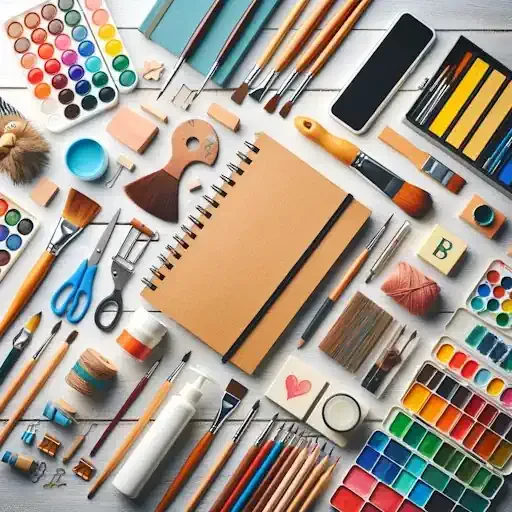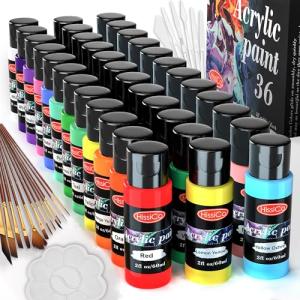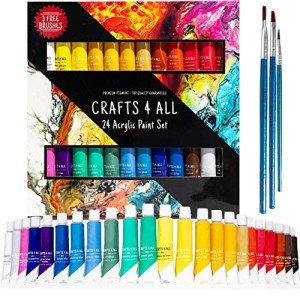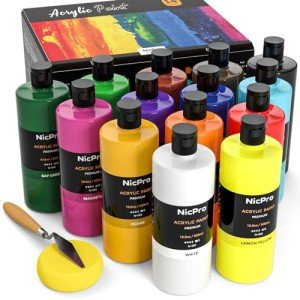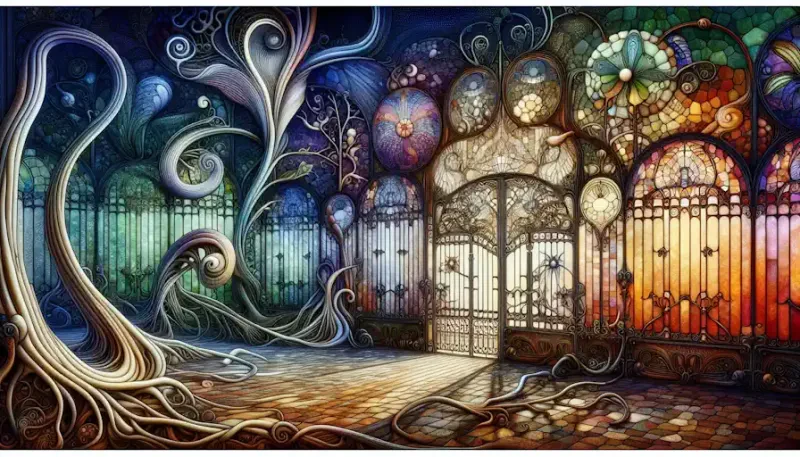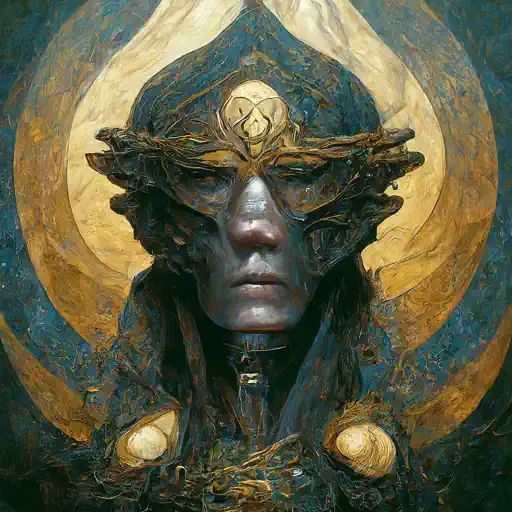Introduction
Choosing the right art supplies is a crucial step for any aspiring artist embarking on their creative journey. From brushes and paints to canvases and drawing tools, the selection process can be overwhelming, especially for beginners. However, mastering the art of selection is essential for honing your craft and achieving your artistic vision.
Importance of Selecting the Right Supplies
The significance of selecting the appropriate art supplies cannot be overstated. Not only do they directly impact the quality of your artwork, but they also influence your creative process and overall artistic experience. Imagine trying to paint a delicate landscape with coarse, low-quality brushes or attempting to blend vibrant colors with inferior paints. The results would likely fall short of your expectations and hinder your artistic growth.
Furthermore, investing in high-quality art supplies demonstrates a commitment to your craft. It shows that you value your work and are dedicated to producing the best possible outcomes. While it's true that art can be created with minimal resources, having access to the right tools can elevate your work to new heights and expand your artistic possibilities.
Overview of the Article
In this article, we will delve into the world of art supplies, providing valuable insights and recommendations to help beginners navigate the selection process with confidence. We will explore various categories of supplies, including brushes, paints, canvases, drawing tools, and more. Each section will cover essential information such as types, factors to consider, recommended brands, and maintenance tips.
Whether you're a budding painter, a sketching enthusiast, or someone eager to explore the world of color, this article aims to equip you with the knowledge and resources needed to make informed decisions about your art supplies. By understanding the importance of selection and learning how to choose the right supplies for your needs, you can lay a solid foundation for your artistic journey and unleash your creative potential.
Benefits of Mastering Selection Skills
Beyond simply acquiring the necessary tools, mastering the art of selection offers numerous benefits for artists at every level. By developing a discerning eye for quality and suitability, you can streamline your workflow, improve the consistency of your work, and achieve greater satisfaction with your artistic endeavors.
Additionally, mastering selection skills empowers you to explore new techniques and styles with confidence. When you have trust in your materials, you can focus more fully on experimenting with different approaches and pushing the boundaries of your creativity. This freedom to explore leads to artistic growth and self-discovery, enriching your experience as an artist.
Furthermore, becoming adept at selecting art supplies opens doors to collaboration and networking within the artistic community. By sharing insights and recommendations with fellow artists, you can contribute to a culture of knowledge exchange and mutual support. In this way, mastering the art of selection becomes not only a personal journey but also a communal endeavor, enriching the creative landscape for all.
Choosing the Right Brushes
Types of Brushes for Beginners
Brushes are essential tools for any painter, and choosing the right ones can significantly impact the outcome of your artwork. For beginners, it's important to understand the various types of brushes available and their intended uses.
Round Brushes: These versatile brushes have a pointed tip and a round ferrule, making them suitable for a wide range of painting techniques, including detail work, washes, and layering.
Flat Brushes: Flat brushes have a squared-off tip and a flat ferrule, making them ideal for creating broad strokes, filling in large areas, and achieving crisp edges.
Filbert Brushes: Filbert brushes have a rounded tip with a flat ferrule, combining the versatility of round and flat brushes. They are great for blending, softening edges, and creating organic shapes.
Fan Brushes: Fan brushes have bristles arranged in a fan shape, making them perfect for creating texture, blending colors, and painting foliage or grassy areas.
Detail Brushes: These small, fine-tipped brushes are designed for intricate work such as fine lines, intricate details, and precise highlights.
Understanding the characteristics and uses of each type of brush will help you select the right ones for your specific needs and artistic style.
Factors to Consider When Selecting Brushes
When choosing brushes, several factors should be taken into consideration to ensure you get the most suitable tools for your artwork.
Bristle Material: Brushes can be made from natural bristles (such as hog hair) or synthetic fibers. Natural bristle brushes are durable and suitable for oil and acrylic paints, while synthetic brushes are often preferred for watercolor and gouache due to their softer bristles.
Size and Shape: Consider the size and shape of the brushes you need for your intended artwork. Larger brushes are suitable for covering large areas, while smaller brushes are better for detail work.
Handle Length: The length of the brush handle can affect your painting technique and comfort level. Longer handles provide better control for larger movements, while shorter handles are more suitable for close-up work and detail.
Price and Quality: While it's tempting to opt for the cheapest brushes available, investing in higher-quality brushes will ultimately yield better results and last longer. Quality brushes maintain their shape and performance over time, making them a worthwhile investment for serious artists.
Recommended Brush Brands
With a plethora of brush brands on the market, it can be challenging to know which ones to choose. However, several reputable brands consistently produce high-quality brushes suitable for beginners.
Princeton Artist Brush Co.: Known for their wide range of brush shapes and affordable prices, Princeton brushes are popular among beginners and professionals alike.
Winsor & Newton: A trusted name in the art supply industry, Winsor & Newton offers a variety of brush lines suitable for different painting techniques and mediums.
Da Vinci Brushes: Handmade in Germany, Da Vinci brushes are renowned for their exceptional quality and durability. They offer a wide selection of brush shapes and sizes to suit every artist's needs.
Blick Master Synthetic Brushes: These affordable synthetic brushes offer excellent performance and durability, making them an ideal choice for beginners on a budget.
By selecting brushes that align with your painting style, preferences, and budget, you can ensure a more enjoyable and successful painting experience.
Selecting Quality Paints
Understanding Different Types of Paints
Paints come in various formulations, each with its unique characteristics and suitability for different artistic techniques and mediums. Understanding the different types of paints available is essential for selecting the right ones for your artwork.
Acrylic Paints: Acrylic paints are versatile and fast-drying, making them popular among beginners and professional artists alike. They can be used on a variety of surfaces and are known for their vibrant colors and long-lasting results. Acrylic paints can be thinned with water for transparent washes or layered for opaque effects.
Oil Paints: Oil paints have a rich, buttery consistency and slow drying time, allowing for blending and manipulation on the canvas. They are well-suited for traditional painting techniques such as glazing, impasto, and alla prima. Oil paints offer a wide range of colors and subtle variations in texture, making them a favorite among many artists.
Watercolor Paints: Watercolor paints consist of pigment suspended in a water-soluble binder, allowing for transparent washes and delicate layering. They are typically applied to paper using a wet-on-wet or wet-on-dry technique and are prized for their luminous, ethereal effects. Watercolor paints require careful planning and technique due to their transparent nature.
Gouache Paints: Gouache paints are similar to watercolors but have a higher pigment concentration and opacity. They can be reactivated with water even after drying, allowing for adjustments and corrections. Gouache paints are popular for illustration, design, and decorative arts due to their versatility and matte finish.
Factors to Consider When Choosing Paints
When selecting paints for your artwork, several factors should be taken into consideration to ensure they meet your needs and preferences.
Pigment Quality: High-quality paints contain a higher concentration of pigment, resulting in richer, more vibrant colors and better lightfastness. Look for paints made with artist-grade pigments for superior color intensity and longevity.
Lightfastness: Lightfastness refers to the paint's resistance to fading when exposed to light over time. Choose paints with good to excellent lightfast ratings to ensure your artwork remains vibrant and true to color for years to come.
Transparency and Opacity: Different paints offer varying levels of transparency and opacity, which can affect how they interact with other colors and surfaces. Consider the desired effects and techniques for your artwork when choosing paints with the appropriate transparency and opacity levels.
Brand Reputation: Opt for paints from reputable brands known for their quality, consistency, and range of colors. Established brands often invest in research and development to ensure their paints meet the needs of artists at every skill level.
Recommended Paint Brands
With numerous paint brands available on the market, it can be challenging to narrow down your options. However, several trusted brands consistently produce high-quality paints suitable for beginners and professionals alike.
Golden Acrylics: Golden is renowned for its extensive range of acrylic paints, including professional-grade colors, mediums, and additives. Their paints are known for their high pigment load, lightfastness, and versatility.
Winsor & Newton Oil Colors: Winsor & Newton offers a wide selection of oil paints in various formulations, including traditional oils, alkyds, and water-mixable oils. Their paints are known for their rich colors, smooth consistency, and excellent lightfastness.
Daniel Smith Watercolors: Daniel Smith is celebrated for its premium watercolor paints made with the finest pigments sourced from around the world. Their paints offer exceptional color intensity, transparency, and lightfastness, making them a favorite among watercolor artists.
Holbein Acryla Gouache: Holbein's Acryla Gouache paints combine the best qualities of acrylic and gouache paints, offering vibrant colors, quick drying time, and matte finish. They are ideal for artists seeking the versatility of acrylics with the opacity of gouache.
By choosing paints that align with your preferred medium, techniques, and artistic goals, you can enhance your painting experience and achieve stunning results in your artwork.
Picking the Perfect Canvas
Types of Canvas Surfaces
The choice of canvas surface can significantly influence the texture, appearance, and overall aesthetic of your artwork. Understanding the various types of canvas surfaces available is essential for selecting the right one for your artistic vision.
Stretched Canvas: Stretched canvas consists of canvas fabric stretched and secured over a wooden frame, creating a flat painting surface. Stretched canvases are available in various sizes and thicknesses, offering artists a versatile option for creating both small and large-scale works.
Canvas Panels: Canvas panels are made by adhering canvas fabric to a rigid backing board, such as cardboard or Masonite. They provide a firm and stable surface for painting and are often used for studies, practice pieces, or artworks intended for framing.
Canvas Rolls: Canvas rolls come in large continuous lengths of canvas fabric, allowing artists to cut and stretch their canvases to custom sizes. Canvas rolls offer flexibility and cost-effectiveness, making them a popular choice for artists who prefer to create their own stretched canvases.
Canvas Boards: Canvas boards are similar to canvas panels but typically have a thinner profile and are less rigid. They are lightweight and portable, making them convenient for outdoor painting or traveling artists. Canvas boards are available in various textures and finishes to suit different painting styles and preferences.
Choosing the Right Canvas Size
The size of your canvas can impact the composition, visual impact, and level of detail in your artwork. When choosing the right canvas size, consider factors such as the subject matter, intended display space, and artistic preferences.
Small Canvases: Small canvases are ideal for intimate or detailed artworks, allowing artists to focus on intricate details and subtle nuances. They are also convenient for experimenting with new techniques or creating studies and sketches.
Medium Canvases: Medium-sized canvases offer a balance between versatility and impact, providing enough space for artists to explore compositions and express their creativity while remaining manageable in terms of handling and display.
Large Canvases: Large canvases make a bold statement and are well-suited for ambitious or expansive artworks. They provide ample space for artists to work on grand-scale compositions, capture sweeping landscapes, or create immersive experiences for viewers.
Custom Sizes: For artists with specific vision or display requirements, custom-sized canvases offer the flexibility to create artworks tailored to their exact specifications. Whether it's a panoramic landscape, a diptych, or a triptych, custom-sized canvases allow artists to unleash their creativity without limitations.
Recommended Canvas Brands
When it comes to choosing canvases, quality matters. Investing in well-made canvases ensures a stable and durable painting surface that will support your artistic endeavors for years to come. Here are some recommended canvas brands known for their quality and reliability:
Blick Premier Gallery Stretched Cotton Canvas: Blick Premier Gallery canvases are made with professional-grade cotton duck canvas stretched over solid wood stretcher bars. They are primed with acid-free acrylic gesso for a smooth and durable painting surface.
Fredrix Red Label Stretched Canvas: Fredrix Red Label canvases feature medium texture, 100% cotton duck canvas stretched over kiln-dried stretcher bars. They are double-primed with acid-free acrylic gesso for optimal paint adhesion and longevity.
Winsor & Newton Professional Stretched Canvas: Winsor & Newton Professional canvases are made with premium-quality, heavyweight cotton canvas stretched over sturdy, warp-resistant wooden frames. They are triple-primed with acid-free gesso for a balanced surface that resists shrinking and cracking.
Arteza Professional Stretched Canvas: Arteza Professional canvases offer high-quality, pre-stretched cotton duck canvas wrapped over kiln-dried stretcher bars. They are triple-primed with acid-free gesso and suitable for a wide range of painting techniques and mediums.
By selecting canvases that align with your preferred surface texture, size requirements, and budget, you can ensure a reliable and supportive foundation for your artistic endeavors. Whether you're painting with oils, acrylics, watercolors, or mixed media, choosing the perfect canvas will enhance your creative process and elevate the quality of your artwork.
Essential Drawing Tools
Pencils: Types and Grades
Pencils are fundamental drawing tools, offering artists precision, control, and versatility in their artwork. Understanding the different types and grades of pencils is essential for selecting the right ones for your drawing needs.
Graphite Pencils: Graphite pencils are the most common type of drawing pencil, consisting of a graphite core encased in a wooden barrel. They come in various grades, ranging from soft to hard, which determine the darkness and hardness of the pencil's marks.
H Pencils: H pencils have a hard graphite core and produce light, fine lines. They are ideal for technical drawing, sketching, and fine details.
HB Pencils: HB pencils have a medium hardness and are considered the standard or "middle ground" pencil grade. They offer a balance between light and dark marks, making them suitable for general drawing and writing.
B Pencils: B pencils have a softer graphite core and produce darker, bolder lines. They are ideal for shading, tonal drawing, and expressive mark-making.
2B, 4B, 6B, 8B Pencils: Pencils with higher B grades have softer graphite cores and produce increasingly darker marks. They are commonly used for creating rich shadows, deep contrasts, and dramatic effects in drawings.
Mechanical Pencils: Mechanical pencils feature a refillable lead cartridge and a mechanism for advancing the lead as it wears down. They offer consistent line width and are suitable for precise drafting, technical drawing, and detailed illustrations.
Colored Pencils: Colored pencils contain pigment cores encased in wooden barrels and come in a wide range of vibrant colors. They are popular for adding color and detail to drawings, illustrations, and mixed media artwork. Colored pencils can be blended, layered, and combined to create rich, textured effects.
Charcoal Pencils: Charcoal pencils contain compressed charcoal cores encased in wooden barrels and are prized for their rich, velvety texture and deep black marks. They are ideal for expressive drawing, gestural sketches, and dramatic tonal studies.
Understanding the characteristics and uses of each type of pencil will help you select the right ones for your drawing style, techniques, and preferences.
Erasers and Sharpeners
Erasers and sharpeners are essential accessories for any artist, offering precision and convenience in correcting mistakes and maintaining drawing tools.
Kneaded Erasers: Kneaded erasers are soft, pliable erasers that can be molded into various shapes to suit different erasing tasks. They are gentle on paper and are ideal for lifting graphite, charcoal, and pastel marks without damaging the surface.
Vinyl Erasers: Vinyl erasers, also known as plastic erasers, are durable and effective erasers suitable for removing graphite and colored pencil marks. They offer clean, smudge-free erasing and are ideal for precise corrections and detail work.
Electric Erasers: Electric erasers feature a motorized eraser tip powered by batteries or electricity, offering precise and efficient erasing for detailed work and large areas. They are particularly useful for erasing fine lines, highlights, and intricate details without damaging the paper.
Manual Sharpeners: Manual sharpeners come in various designs, including handheld sharpeners, desk-mounted sharpeners, and mechanical sharpeners. They are used to sharpen pencils to a fine point for precise drawing and writing.
Understanding the different types and features of erasers and sharpeners will help you choose the right tools for your drawing needs, ensuring clean, accurate, and efficient results in your artwork.
Paper Options for Sketching
The choice of paper is crucial for drawing, as it affects the texture, tooth, and durability of the drawing surface. Different papers offer unique characteristics suited to various drawing techniques, mediums, and artistic preferences.
Sketchbooks: Sketchbooks are portable and convenient pads of paper bound together, offering a dedicated space for sketching, doodling, and brainstorming ideas. They come in various sizes, paper weights, and bindings to suit different preferences and usage requirements.
Drawing Pads: Drawing pads consist of loose sheets of paper bound together with a spiral or glue binding, providing a versatile and customizable drawing surface. They are available in a wide range of paper types, including smooth, textured, and toned papers, offering options for different drawing styles and mediums.
Bristol Board: Bristol board is a heavyweight, smooth-surfaced paper commonly used for detailed drawings, illustrations, and ink work. It provides a crisp, clean surface for precise linework and fine details and is suitable for a variety of dry and wet mediums, including graphite, ink, and markers.
Mixed Media Paper: Mixed media paper is designed to withstand a variety of drawing and painting techniques, including wet and dry media. It typically has a medium weight and a textured surface that can handle multiple layers of paint, ink, pastel, and collage materials.
Choosing the right paper for your sketches involves considering factors such as paper weight, texture, and intended usage. Experimenting with different papers will help you discover the surfaces that best suit your drawing style, techniques, and preferences.
Additional Tools for Drawing
In addition to pencils, erasers, and paper, there are various other drawing tools and accessories that can enhance your drawing experience and expand your creative possibilities.
Blending Tools: Blending tools such as blending stumps, tortillons, and blending brushes are used to soften edges, blend colors, and create smooth transitions in drawings. They are particularly useful for shading, smudging, and creating subtle gradations of tone.
Rulers and Straightedges: Rulers, straightedges, and drafting triangles are essential tools for creating precise lines, angles, and geometric shapes in technical drawings, architectural sketches, and perspective drawings. They provide stability and accuracy in drafting and design work.
Fixative Spray: Fixative spray is a clear, protective coating applied to finished drawings to seal and protect the surface from smudging, fading, and moisture damage. It helps preserve the integrity of the artwork and extend its longevity over time.
Drawing Boards: Drawing boards provide a sturdy and portable surface for drawing, sketching, and painting on the go. They offer support for paper and drawing materials and can be easily carried and set up for outdoor sketching sessions or life drawing classes.
By exploring the wide range of drawing tools available, you can find the tools and accessories that best suit your artistic style, techniques, and preferences, enhancing your drawing experience and enabling you to create expressive and compelling artworks.
Exploring Color Theory
Basics of Color Theory for Beginners
Color theory is a fundamental aspect of art and design, exploring the principles and relationships of colors in the visual spectrum. Understanding the basics of color theory is essential for artists of all levels, as it provides a framework for creating harmonious, dynamic, and visually appealing artwork.
Primary Colors: The primary colors—red, blue, and yellow—are the building blocks of all other colors. They cannot be created by mixing other colors together and are used to create secondary and tertiary colors.
Secondary Colors: Secondary colors are created by mixing equal parts of two primary colors together. The three secondary colors are orange (red + yellow), green (yellow + blue), and violet (blue + red).
Tertiary Colors: Tertiary colors are created by mixing a primary color with a neighboring secondary color. There are six tertiary colors, including red-orange, yellow-orange, yellow-green, blue-green, blue-violet, and red-violet.
Color Wheel: The color wheel is a visual representation of the relationships between primary, secondary, and tertiary colors. It is divided into warm colors (reds, oranges, yellows) and cool colors (greens, blues, violets), with complementary colors (opposite each other on the color wheel) creating dynamic contrasts and harmonies.
Color Mixing Techniques
Color mixing is the process of combining different colors to create new colors, shades, and tones. Understanding color mixing techniques allows artists to achieve a wide range of colors and effects in their artwork.
Additive Color Mixing: Additive color mixing occurs when colored light is combined, such as on a computer screen or in stage lighting. The primary colors in additive color mixing are red, green, and blue (RGB), with different combinations producing secondary and tertiary colors.
Subtractive Color Mixing: Subtractive color mixing occurs when colored pigments are combined, such as in painting or printing. The primary colors in subtractive color mixing are cyan, magenta, and yellow (CMY), with different combinations producing secondary and tertiary colors.
Color Temperature: Color temperature refers to the perceived warmth or coolness of a color. Warm colors (reds, oranges, yellows) evoke feelings of warmth, energy, and vitality, while cool colors (greens, blues, violets) evoke feelings of calmness, serenity, and introspection.
Color Harmony: Color harmony refers to the pleasing arrangement of colors in artwork, achieved through careful selection and arrangement of colors based on their relationships and contrasts. Common color harmonies include complementary colors (opposite each other on the color wheel), analogous colors (adjacent to each other on the color wheel), and triadic colors (equidistant on the color wheel).
Recommended Color Theory Resources
Learning about color theory is an ongoing process, and there are many resources available to help artists deepen their understanding and mastery of color.
Books: There are numerous books on color theory and color mixing techniques available for artists of all levels. Some recommended titles include "Color and Light: A Guide for the Realist Painter" by James Gurney, "Interaction of Color" by Josef Albers, and "The Elements of Color" by Johannes Itten.
Online Courses: Many online platforms offer courses and tutorials on color theory, ranging from beginner to advanced levels. Websites such as Skillshare, Udemy, and Coursera provide access to a wide range of courses taught by experienced instructors.
Workshops and Classes: Local art schools, community centers, and art studios often offer workshops and classes on color theory and painting techniques. These hands-on learning experiences allow artists to interact with instructors and fellow students while exploring color concepts in depth.
Practical Application: Ultimately, the best way to learn about color theory is through practice and experimentation. By applying color theory concepts in your artwork and observing the effects of different color combinations, you can develop a deeper understanding of color relationships and how they contribute to the overall impact of your work.
By exploring color theory principles and experimenting with color mixing techniques, artists can enhance their artistic expression, create dynamic compositions, and imbue their artwork with depth, emotion, and visual interest.
Selecting Supportive Materials
Easels: Types and Features
Easels are essential tools for providing support and stability to artists while they work on their artwork. Understanding the different types and features of easels is crucial for selecting the right one to suit your artistic needs and preferences.
Studio Easels: Studio easels are large, sturdy easels designed for use in indoor studio settings. They typically feature adjustable height and tilt mechanisms, allowing artists to position their canvas at various angles for optimal working comfort and visibility. Studio easels are available in different styles, including H-frame, A-frame, and single-mast designs.
Tabletop Easels: Tabletop easels are compact, portable easels designed to sit on a table or desk. They are ideal for smaller artworks, studies, or plein air painting sessions where space is limited. Tabletop easels often feature adjustable angles and foldable designs for easy storage and transportation.
Plein Air Easels: Plein air easels are lightweight, portable easels designed for outdoor painting excursions. They are typically collapsible or tripod-based, allowing artists to set up their easel quickly and securely on uneven terrain. Plein air easels often feature adjustable legs, telescoping arms, and built-in storage compartments for painting supplies.
Display Easels: Display easels are decorative easels designed to showcase artwork, photographs, or signage in homes, galleries, or events. They come in various styles and materials, including metal, wood, and acrylic, and can be freestanding or wall-mounted. Display easels are a versatile and elegant way to present artwork and add visual interest to any space.
Palettes: Options and Considerations
Palettes are essential tools for mixing and holding paint while working on artwork. Understanding the different options and considerations when choosing a palette is important for finding the right one to suit your painting style and preferences.
Traditional Palettes: Traditional palettes are flat, handheld surfaces typically made from wood, plastic, or ceramic. They feature multiple wells or compartments for holding different colors of paint and a larger mixing area for blending and mixing colors. Traditional palettes are durable, easy to clean, and suitable for a wide range of painting mediums.
Stay-Wet Palettes: Stay-wet palettes are designed to keep acrylic and watercolor paints moist and workable for extended periods, reducing waste and allowing artists to work on their artwork over multiple sessions. They consist of a shallow tray with a sponge or membrane underneath a permeable palette paper, which keeps the paints hydrated by wicking moisture from the sponge.
Disposable Palettes: Disposable palettes are convenient, single-use palettes made from disposable materials such as paper or wax-coated paper. They are lightweight, portable, and ideal for plein air painting, workshops, or classes where cleanup and storage space are limited. Disposable palettes are available in various sizes and formats, including pads, sheets, and tear-off palettes.
Palette Knives: Palette knives are versatile tools used for mixing, applying, and manipulating paint on palettes and canvas surfaces. They come in various shapes and sizes, including straight-edged, trowel-shaped, and diamond-shaped knives, each offering different benefits for palette work and impasto techniques.
Other Supportive Materials for Painting
In addition to easels and palettes, there are various other supportive materials and accessories that can enhance your painting experience and workflow.
Paint Racks and Organizers: Paint racks and organizers are designed to hold and organize tubes, bottles, and jars of paint, keeping them easily accessible and visible while you work. They come in various styles and configurations, including tabletop racks, wall-mounted racks, and carousel organizers.
Brush Washers and Cleaners: Brush washers and cleaners are essential for maintaining the cleanliness and condition of your brushes while painting. They typically consist of a container filled with solvent or water for rinsing brushes and a coil or grid for agitating and removing paint from the bristles.
Painting Mediums and Additives: Painting mediums and additives are used to modify the characteristics of paint, such as viscosity, drying time, and finish. They include products such as acrylic mediums, oil painting mediums, varnishes, and texture gels, allowing artists to achieve specific effects and enhance the performance of their paints.
Protective Gear: Protective gear such as aprons, gloves, and respirators is essential for keeping artists safe and comfortable while working with paints, solvents, and other art materials. They help prevent stains, spills, and exposure to harmful fumes, ensuring a healthier and more enjoyable painting experience.
By selecting supportive materials that align with your painting style, preferences, and workflow, you can create a well-equipped and organized workspace that enhances your creativity and productivity as an artist. Whether you're working in a studio, outdoors, or at home, having the right tools and accessories at your disposal will enable you to focus on your artwork and achieve your artistic vision with confidence.
Organizing Your Workspace
Importance of a Well-Organized Workspace
A well-organized workspace is essential for fostering creativity, productivity, and efficiency in your artistic endeavors. By creating an environment that is conducive to focused work and creative exploration, you can enhance your artistic process and maximize your potential as an artist.
Creativity: A clutter-free and organized workspace provides a clean and uncluttered canvas for your creativity to flourish. It allows you to focus on your artwork without distractions, enabling you to explore new ideas, techniques, and concepts with clarity and intention.
Productivity: An organized workspace streamlines your workflow and saves you time and energy searching for tools, materials, and references. It enables you to work more efficiently and effectively, allowing you to devote more time to creating and less time to organizing and tidying up.
Inspiration: A well-organized workspace can inspire and motivate you to create your best work. Surrounding yourself with your favorite art supplies, reference materials, and inspirational artwork can ignite your imagination and fuel your passion for creativity.
Mental Clarity: Clutter and disorganization can create mental clutter and hinder your ability to focus and concentrate on your artwork. By maintaining an organized workspace, you can create a sense of calm and order that promotes mental clarity and creative flow.
Tips for Arranging Art Supplies
Arranging your art supplies in a logical and accessible manner is key to maintaining an organized workspace. Here are some tips for arranging your art supplies effectively:
Group Similar Items Together: Organize your art supplies into categories, such as paints, brushes, drawing tools, and reference materials, and group similar items together. This makes it easier to locate specific tools and materials when you need them.
Use Storage Containers: Utilize storage containers, bins, drawers, and shelves to keep your art supplies organized and contained. Choose containers that are transparent or labeled to easily identify the contents inside.
Keep Frequently Used Items Within Reach: Place frequently used art supplies within arm's reach of your workspace to minimize the time spent searching for them. Keep less frequently used items stored away but easily accessible when needed.
Establish Work Zones: Designate specific areas of your workspace for different tasks, such as painting, drawing, and reference materials. This helps create a sense of order and structure and prevents clutter from spreading throughout your workspace.
Storage Solutions for Art Materials
Proper storage of art materials is essential for preserving their quality and longevity. Here are some storage solutions for common art materials:
Paint Tubes and Jars: Store paint tubes and jars upright in airtight containers or organizers to prevent them from drying out or leaking. Keep them in a cool, dry place away from direct sunlight to maintain their freshness and consistency.
Brushes: Store brushes vertically in containers or jars with bristles facing upward to prevent them from bending or becoming misshapen. Avoid overcrowding brushes to allow air circulation and prevent damage to bristles.
Drawing Tools: Store drawing tools such as pencils, erasers, and sharpeners in pencil cases, trays, or organizers to keep them organized and protected. Consider using separate containers for different types of drawing tools to prevent them from rolling around and becoming damaged.
Papers and Canvases: Store papers and canvases flat or upright in drawers, portfolios, or flat files to prevent them from bending, wrinkling, or becoming damaged. Use acid-free tissue paper or interleaving sheets to protect delicate papers and artworks from damage.
Creating an Inspiring Environment for Creativity
Your workspace should not only be organized and functional but also inspiring and conducive to creativity. Here are some tips for creating an inspiring environment for your artistic endeavors:
Personalize Your Space: Surround yourself with artwork, photographs, objects, and mementos that inspire and motivate you. Display your own artwork and works-in-progress to remind yourself of your creative journey and accomplishments.
Let in Natural Light: If possible, position your workspace near a window or source of natural light to create a bright and inviting environment. Natural light can enhance your mood, focus, and productivity while reducing eye strain and fatigue.
Add Plants and Greenery: Incorporate plants and greenery into your workspace to bring a touch of nature indoors and create a calming and rejuvenating atmosphere. Plants can improve air quality, reduce stress, and boost creativity and productivity.
Minimize Distractions: Identify and minimize distractions in your workspace to create a focused and conducive environment for creativity. This may include turning off notifications, setting boundaries with others, and creating designated times for focused work.
By organizing your workspace thoughtfully, storing art materials properly, and creating an inspiring environment for creativity, you can optimize your artistic process and create an environment that supports your growth and success as an artist. Whether you're working in a studio, at home, or outdoors, a well-organized and inspiring workspace lays the foundation for your artistic journey and empowers you to create your best work.
Maintaining Your Artistic Practice
Importance of Consistent Practice
Consistent practice is essential for artists to develop their skills, refine their techniques, and grow creatively over time. By making a commitment to regular practice, artists can cultivate discipline, resilience, and a deeper understanding of their craft.
Skill Development: Regular practice allows artists to hone their skills and master new techniques through repetition and refinement. Whether it's drawing, painting, sculpting, or any other artistic discipline, consistent practice builds muscle memory, hand-eye coordination, and technical proficiency.
Creative Exploration: Practice provides artists with the opportunity to experiment, take risks, and explore new ideas and approaches in their artwork. It encourages creative freedom and innovation, fostering a sense of curiosity, playfulness, and discovery in the artistic process.
Growth and Improvement: Over time, consistent practice leads to continuous growth and improvement as artists challenge themselves, overcome obstacles, and push the boundaries of their creativity. Each practice session builds upon the last, incrementally advancing skills, knowledge, and artistic vision.
Self-Expression: Practice is a means of self-expression and personal development for artists, allowing them to communicate their thoughts, emotions, and experiences through their artwork. It fosters self-awareness, authenticity, and a deeper connection to oneself and others through the creative process.
Establishing a Practice Routine
Establishing a practice routine is key to maintaining consistency and momentum in your artistic practice. Here are some tips for creating a practice routine that works for you:
Set Goals: Define clear and achievable goals for your artistic practice, whether it's mastering a specific technique, completing a series of artworks, or exploring a new artistic style. Break down larger goals into smaller, manageable tasks to keep yourself motivated and focused.
Schedule Regular Practice Sessions: Block out dedicated time in your schedule for artistic practice, treating it as you would any other important commitment or appointment. Whether it's daily, weekly, or monthly practice sessions, consistency is key to making progress and seeing results.
Create a Dedicated Workspace: Designate a specific area of your home or studio as your creative workspace, free from distractions and conducive to focused work. Make it comfortable, inspiring, and equipped with all the tools and materials you need for your practice sessions.
Find Your Rhythm: Experiment with different practice routines and schedules to find what works best for you. Some artists thrive with structured, regimented practice sessions, while others prefer more spontaneous and flexible approaches. Listen to your body and mind, and adjust your routine accordingly.
Overcoming Challenges and Maintaining Motivation
Maintaining a consistent artistic practice is not without its challenges, but there are strategies for overcoming obstacles and staying motivated along the way:
Embrace Imperfection: Accept that not every practice session will be perfect or yield immediate results. Embrace mistakes, setbacks, and failures as opportunities for learning and growth, rather than reasons to become discouraged or give up.
Seek Inspiration: Surround yourself with sources of inspiration that ignite your creativity and fuel your passion for art. Whether it's visiting galleries, museums, or art shows, immersing yourself in nature, or connecting with other artists online or in person, seek out experiences that inspire and energize you.
Stay Flexible: Be open to adjusting your practice routine as needed to accommodate changes in your schedule, interests, or priorities. Life is unpredictable, and it's okay to adapt and evolve your practice routine to suit your current circumstances and needs.
Celebrate Progress: Celebrate your achievements, no matter how small, and acknowledge the progress you've made along your artistic journey. Keep a journal or sketchbook to track your growth and reflect on your experiences, successes, and areas for improvement.
By establishing a practice routine, overcoming challenges, and staying motivated, artists can cultivate a lifelong commitment to their craft and continue to evolve and thrive creatively. Consistent practice not only strengthens artistic skills but also nurtures a deeper sense of fulfillment, purpose, and joy in the creative process.
The Start of a Beautiful Journey
Choosing the right art supplies as a beginner is about finding a balance between quality and simplicity. The tools listed in this guide are designed to give you the best start possible, providing the essentials without overwhelming you with too many choices. With these supplies in hand, you’re well-equipped to embark on your artistic journey, exploring your creativity and developing your skills one stroke at a time.
As you progress, you will find your preferences and style, which will guide your future choices in art supplies. But for now, enjoy the process of learning and creating. Your artistic journey is a personal and rewarding adventure that begins with these first simple steps,
